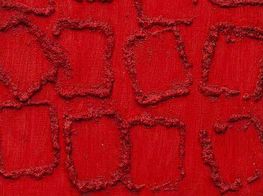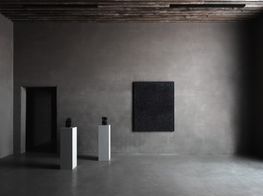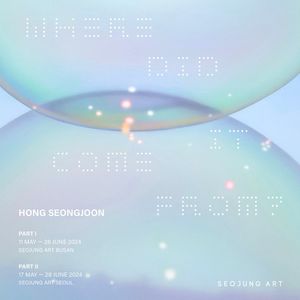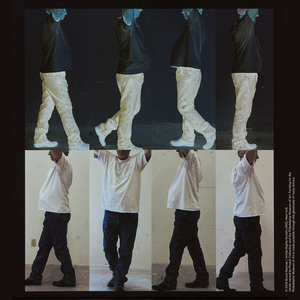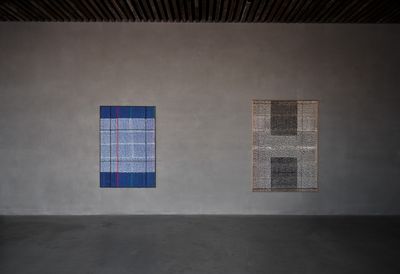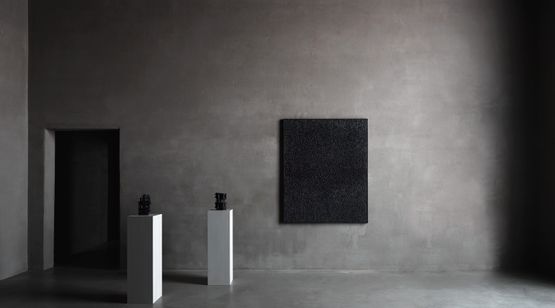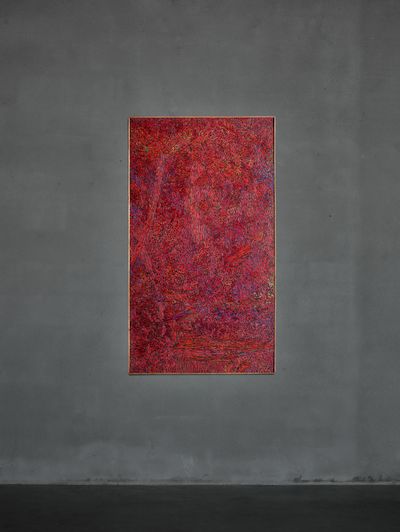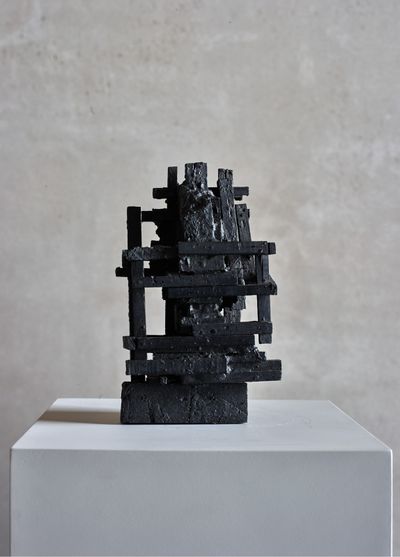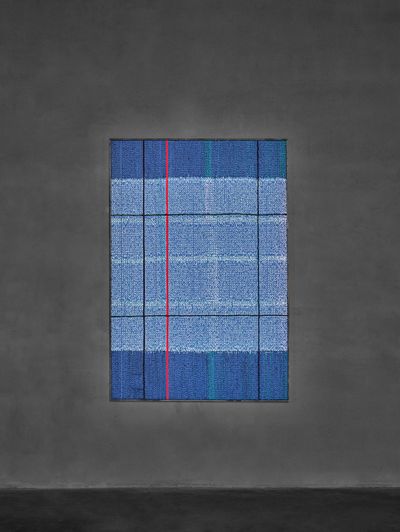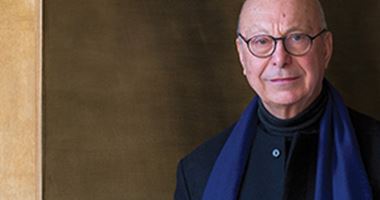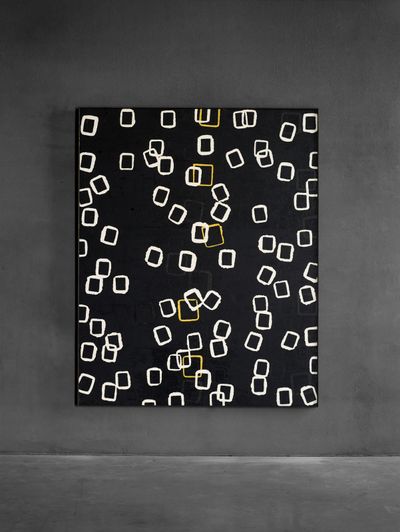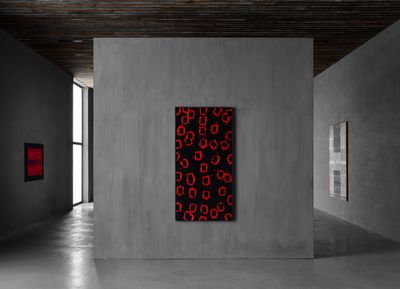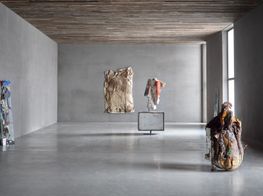Chiyu Uemae: Beyond Gutai
Over 9,000 kilometres from Chiyu Uemae's home city of Kyoto, an austere solo survey of the Gutai artist at Axel Vervoordt in Antwerp offers space to reflect on a seven-decade-long practice.
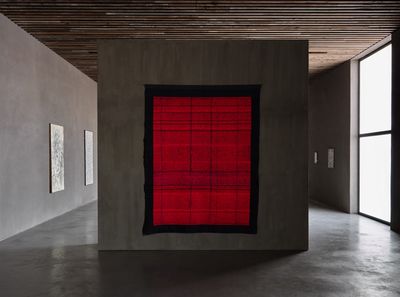
Exhibition view: Chiyu Uemae, Axel Vervoordt Gallery, Wijnegem (11 February–22 April 2023). Courtesy Chiyu Uemae Estate and Axel Vervoordt Gallery.
Though one of Gutai Art Association's original founding members, Chiyu Uemae (1920–2018) is lesser known outside of Japan. Unlike artists such as Shozo Shimamoto, Atsuko Tanaka, Takesada Matsutani, Minoru Onoda, or association founder Jirō Yoshihara, who went on to gain significant international recognition in independent careers following the dissolution of Gutai in 1972, Uemae's post-Gutai works have seldom been presented outside of Japan.
Uemae exhibited for the first time in 1947 in a group show at the Tokyo Metropolitan Art Museum. In his early years, Uemae worked in the Nanga style, a Japanese genre influenced by Chinese literati painting. With no formal art training, he was more aligned with the working class—holding various jobs as an industrial labourer, crane operator, and apprentice in a textile dyeing facility in Kyoto.
Uemae met Jirō Yoshihara in 1953, the year before the formation of Gutai Art Association, in Ashiya, a humble city in Hyogo prefecture, and under Yoshihara's guidance, Uemae developed his painting.
In the years of Gutai, Uemae's oil paintings and mixed-media works were presented widely—he participated in every Gutai exhibition, remaining steadfastly involved with the collective until its conclusion. At the peak of its 18-year history, the group engaged nearly 60 members.
In the revolving door of Gutai surveys and retrospectives—those in the past decade or so including GUTAI: Splendid Playground at the Solomon R. Guggenheim Museum, New York (2013); Tokyo 1955–1970: A New Avant-Garde at the Museum of Modern Art, New York (2012); and GUTAI: The Spirit of an Era at The National Art Center, Tokyo (2012)—Uemae's work makes a reliable appearance.
With a practice that continued to evolve for many decades beyond the group's conclusion, it is somewhat surprising that international perception of Uemae remains stubbornly fixed to the postwar years. This could partly be attributed to the nature of Uemae's practice, which even during Gutai's active years aligned less closely with the association's public image as proponents of radical performance practice with conceptual, experimental approaches to material, action, process, and environment.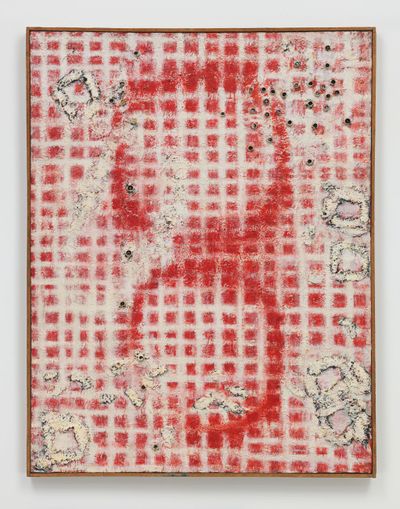
Where Kazuo Shiraga's now-canonical performance Challenging Mud (1955), for Gutai's first exhibition in Tokyo, captured the artistic consciousness of audiences and critics, early works by Uemae such as Untitled (1963) or Untitled (1966) appear comparatively restrained or traditional—or easily compartmentalised under the umbrella of postwar modernism or Abstract Expressionism.
At Axel Vervoordt's Terrace Gallery in Wijnegem, Antwerp, Chiyu Uemae (11 February–22 April 2023) collects distinct periods in the artist's practice, from his 'pointillist' paintings of the 1950s and 60s during the Gutai era, his Kigumi (meaning 'wooden framework') sculptures of the 1970s and Nui (stitch) textile works of the 1980s and 90s, through to his late-career oil paintings. Uemae remained active in his practice through his nineties until his death in 2018.
The sparse distribution of works through the gallery elevates each painting, sculpture, and Nui piece to an almost idolatrous status, encouraging a slow, considered visual absorption of the topographical details of every work. One moves along the lengthy timeline of Uemae's career with the meditative ease of landscape, in vastness and detail, if not in subject.
Uemae's distinct pointillist technique can be seen in the mottled-yellow painting Untitled (1971). The neighbouring work Untitled (1966) is rendered in longer dashes, smothering the canvas surface with perceivably thick strokes of red-based tones.
Positioned in front of the pair is the sculpture Untitled (c. 1972), constructed in a mixture of saw dust and oil and created around the tail end of Gutai's formal lifetime. Its cavernous, rock-like form, plastered with thick, fleshy impasto dots of yellow oils, emits a warm glow against the cool grey interior of the gallery.
Uemae was less opposed to traditional forms of beauty in art than other Gutai members. He persevered in a practice that showed an appreciation for aesthetics, repetition, and the 'psychic automatism' that the group outwardly rejected in the postwar period. His sculptures also reflect a quiet engagement with repeated action, with protruding wooden sticks painted in black sumi ink assembled in quasi-architectural fashion in Untitled (c. 1973).
Uemae's impeccable approach to materiality, for its capacity to mediate gesture and surface, carried through from his pointillist paintings to his later Nui works. He began working with textiles and stitching from the mid-1970s, and several examples of these are presented at Axel Vervoordt. Silks and cloths are meticulously stitched with minimal abstract compositions, colour blocks, and geometric grid-like forms. Irregularities of the hand and shifting densities of stitch can only be appreciated when viewed up close. Uemae made 176 of these Nui works between 1975 and 1997 and returned to rework many after completion.
In NUI-(26) (1989–1992), a large blue cloth is covered in white and green stitching. It is divided compositionally with thick, dark grid lines, formed by the tight stitching together of infinite short strokes—so dense that they protrude from the textile's surface to appear tubular. For many of the Nui works, including this piece, Uemae used a check backing cloth to support a faster process of hand stitching.
Uemae's later oil paintings zoomed out again, repeatedly featuring patterns formed of rounded-edged rectangles of varying sizes and shapes. Untitled (1992) assumes the scale ratio of a doorway or tall window, and depicts irregular tessellations of red squares with organic, splattered outlines against a black void. Comparably, the monochromatic Untitled (1993) features cleaner white rectangular forms, with thin yellow polygons cascading vertically down the centreline.
Writing for Artforum on the Guggenheim's GUTAI: Splendid Playground exhibition in 2013, Joan Kee considered 'the capacity of its members to think of painting as an intrinsically elastic structure, unencumbered by any false promises of fidelity to the medium and liberated by a uniquely fluid understanding of the interaction between notions of frame, support, gesture, and trace.'1
To present Uemae's enduring independent practice both within and outside of the framework of Gutai to which it is widely attached enables a breadth of interpretation, unbounded by historical timestamps or collective intent while carrying on a spirit of experimental and experiential production. —[O]
